
Manufacturer's Specifications:
Turntable:
Speeds: 33 1/3 and 45 rpm, with manual speed change.
Drive System: Round-section peripheral belt and a.c. synchronous motor.
Power Requirements: 110 V a.c., 60 Hz or 240 V a.c., 50 Hz (factory preset): less than 4 watts.
Dimensions: 16 1/2 in. W x 14 3/16 in. D x 5 5/16 in. H (42 cm x 36 cm x 13.5 cm).
Weight: 14.3 lbs. (6.5 kg).
Price: $400 in red beechwood or $350 in black ash; with factory-installed Revolver Standard tonearm, $175 additional.
Tonearm:
Effective Length: 9 in. (228 mm).
Recommended Cartridge Compliance Range: 4 to 50 c.u. (1 c.u. equals 10^ 6 cm/dyne).
Adjustments: Tracking and anti-skating force, arm and cueing height, and overhang.
Cables: 47 1/4 in. (120 cm), color-coded. gold-plated connectors.
Price: $200.
Cartridge:
Type: Moving magnet.
Frequency Response: 20 Hz to 20 kHz.
Channel Separation: Greater than 20 dB at 1 kHz.
Channel Balance: Within 2.0 dB at 1 kHz.
Output: 3.5 mV for 5-cm/S rms lateral velocity at 1 kHz.
Recommended Load Capacitance: 100 to 200 pF.
Stylus Shape: Elliptical, 0.4 x 0.7 mil.
Optimum Tracking Force: 1.7 grams.
Mounting Type: Standard 1/2-inch spacing.
Weight: 5.8 grams.
Price: $125.
Company Address: c/o Music Hall, 108 Station Rd., Great Neck, N.Y. 11023.
There are many people who have collections of LP and 45-rpm records who are still interested in the possibility of upgrading their systems. I imagine that you are probably one of them, since you are reading this report on the Revolver turntable. Someone who was interested in buying a completely new music system recently told me something very interesting. He said that he was in a music store to find out what was available and a salesman demonstrated a $2,000 system complete with receiver, cassette deck, CD player, turntable, and loudspeakers. The salesman was really enthusiastic about the CD player, but when asked for more information about the turntable, he gave it short shrift.
When pressed for more information, he shrugged his shoulders and said he didn't have any details--it was just a record player. So the prospective buyer told me that al though he thought the system was really great sounding, he left the store. He said that he had hundreds of records and if he got a new system, he certainly wanted it to include a really good turntable, especially if the system cost $2,000! I think that this experience is probably typical of many people's today. It is the good fortune of such people that there are many fine, moderately priced turntables still avail able. Even more interesting to me is the fact that new turntables continue to be introduced when you might think that the Compact Disc revolution would discourage companies from doing so.
The Revolver turntable has been available for a few years in England, but now it is being imported to the U.S. by Music Hall. It is a complete record player, since it can be bought as a system which includes the Revolver Standard tonearm and the Bullet cartridge. Buying a complete record-playing system from the same manufacturer should have some advantages, since it can be assumed that all the parts have been made to work well together. At least the problems of mounting a separate tonearm to the turntable have been eliminated, although the Revolver turntable can be purchased as a separate item, for those who would like the option of using a different arm.
----------- MEASURED DATA -----------
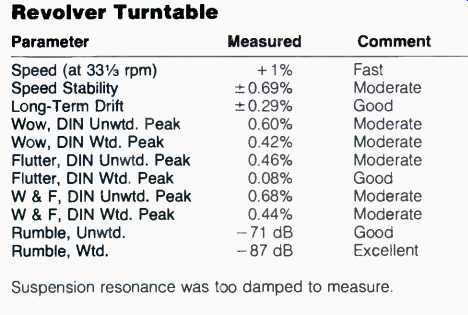
Suspension resonance was too damped to measure.
Revolver Tonearm
Pivot-to-Stylus Distance: 8.8125 in. (224 mm).
Pivot-to-Rear-of-Arm Distance: 2.375 in. (60 mm).
Overall Height Adjustment: 0.75 in. (19 mm).
Tracking Force Adjustment: Sliding counterweight on armtube.
Tracking Force Calibration: 0 to 3.0 grams, within 0.1 gram.
Cartridge Weight Range: 2 to 10 grams.
Counterweights: One 97 grams.
Counterweight Mounting: Direct to armtube.
Sidethrust Correction: Calibrated knob on base of main pillar.
Pivot Damping: None.
Lifting Device: Fingerlift on headshell and damped cueing lever.
Headshell Offset: 23°.
Overhang Adjustment: Slots in headshell.
Bearing Alignment: Good.
Bearing Friction: Very low.
Bearing Type: Horizontal, ball race; vertical, jewel point.
Lead Torque: Very low.
Arm-Lead Capacitance: 135 pF with external phono cable.
Arm-Lead Resistance: 1.0 ohm with external phono cable.
External Lead Length: 48 inches.
Structural Resonances: 450, 950, 1350, 1750, 2600, 4400, 4600, and 7950 Hz.
Base Mounting: 1 1/6-inch-diameter hole for main pillar and 2 3/6-inch-diameter clearance for tonearm base.
Revolver Bullet Cartridge
Coil Inductance: 390 mH, both channels.
Coil Resistance: 408 ohms, both channels.
Output Voltage: Left, 0.71 mV/cm/S; right, 0.64 mV/cm/S.
Cartridge Mass: 5.6 grams.
Microphony: Very good.
Hum Rejection: Very good.
Rise-Time: 20 uS.
High-Frequency Resonance: 25.1 kHz.
Low-Frequency Resonance: 11 to 12 Hz.
Low-Frequency Q: 1.5 to 4.4.
Recommended Load Resistance: 47 kilohms.
Recommended Load Capacitance: 250 pF.
Recommended Tracking Force: 2.0 grams.
Polarity: Positive.
-----------
First Impressions
The Revolver turntable that I tested was finished in red and is certainly very eye-catching. It might not appeal to everyone, though, so it is available in a black ash finish as well. The Revolver is built using two separate platforms, one slightly smaller than the other. This is what the manufacturer calls their "split plinth construction," in which the motor, turntable bearing, tonearm, and a.c. power switch are mounted on the smaller, upper platform. The power circuitry and cover hinges are mounted on the lower platform. These two platforms, or "plinths," are connected together by two 1-inch-wide x 12-inch-long strips of neoprene rubber, which provide what I think is a very stiff mounting. The rubber mounting feet, attached to the bottom of the larger platform, are a little more compliant, but they are still stiff by comparison to those on many other turntables. The tonearm is made in Japan by Jelco and has no features which could be called radical.
I performed my usual test for bearing integrity by holding the main pillar in one hand while I tried to gently pull, push, and twist the armtube with my other hand. There was no discernible play in the bearings, and the tonearm exhibited very low friction in the normal horizontal and vertical planes of motion.
I also performed the tap test on the armtube to listen for any audible resonances. If any resonances can be heard during this test, it is quite likely that they will cause coloration in the reproduced sound. If the armtube is well damped, these resonances are harder to distinguish and therefore less likely to cause serious degradation of the reproduced sound. When an armtube has many resonances which are not harmonically related, the sound is more like a noise and it is harder to hear a definite pitch. The sound emitted by the Revolver tonearm varied from one end of the armtube to the other. Near the cartridge, the sound was a "tank"; in the middle, it was a "tack," and near the pillar, it was a lock." This indicated to me that no damping is used inside the armtube and that vibrations are damped only by the main bearings.
Features
The Revolver is a belt-drive turntable which offers both 33 1/3- and 45-rpm speeds. The motor has a two-step pulley, and the speed change is accomplished by moving the belt from one pulley to the other. The belt is seamless, round, 0.080 inch in diameter, and made of rubber. The motor is a 12-pole synchronous type made by Landis & Gyr of Switzerland. A synchronous a.c. motor is of the type which locks to the frequency of the a.c. power line. While a variation of the a.c. line voltage can affect the torque of the motor, the speed will remain constant as long as the frequency of the a.c. power line remains constant. While everyone is probably aware that the a.c. power-line voltage can vary up and down quite dramatically, the frequency of the power line is very precisely regulated here in the U.S. to be exactly 60 Hz. This is necessary because the power system is generally locked together across the country, and when generators are running together, they must be at the same frequency or chaos would ensue. Also, if a generator running at the wrong speed were accidentally put on the system, it could be destroyed. Since the frequency of the a.c. power line is so closely controlled, an a.c. motor of the synchronous type can be counted on to run at exactly the correct speed. It is fairly easy to determine the diameter of the platter and the motor pulleys necessary to achieve any desired turntable speed. The Revolver is one of the few turntables I have tested which works directly from the a.c. power line. Because there are no step-down transformers, a.c.-to-d.c. converters, or electronic speed-control circuits, the motor has to be of excellent quality to achieve high-quality music reproduction.
Another important factor in turntable performance is the quality of the main platter bearing and the precision of the 0.375-inch-diameter shaft; computer-controlled machining is used to ensure an accuracy of 0.0001 inch. The typical clearance for the shaft and bearing, 0.0004 inch, is born out by the fact that when the shaft has a thin coating of oil, it takes up to 30 minutes for it to slide down into the bearing well. The contact point for the flat end of the main shaft is a captive ball bearing at the bottom of the bearing well; it also appears to be of high quality.
The main platter is injection-molded of glass-filled polyphenylene and has three concentric reinforcing rings on the underside; these are at diameters of 3 3/4, 6 1/4, and 8 7/8 inches. The platter mat, which is made of a felt material, is about 1/16-inch thick and is treated so that it will conduct static charges away from the record. It is not intended to absorb energy from the record, as most of the mats found on other turntables are.
The Revolver Standard tonearm is a statically balanced type. This means that the tracking force is set by moving the counterweight, located on the rear of the armtube, toward the main pillar. There is a scale, calibrated from 1 to 3 grams, which rotates with the counterweight, making the tracking-force adjustment easy. After the counterweight is set to balance the cartridge weight, the calibrated scale is rotated so the zero is next to the white cursor line on the armtube. Then the counterweight is rotated toward the tonearm pillar until the desired tracking-force figure is lined up with the cursor. The sidethrust or anti-skating force is set by rotating a calibrated knob on a platform which sticks out from the tonearm's main pillar. It is also calibrated from 1 to 3 grams, to match the tracking force. The height of the tonearm can be adjusted to allow for different cartridges or to change the vertical tracking angle. The stylus overhang can be adjusted by sliding the cartridge and then tightening the mounting bolts in the slots provided in the headshell. A template is supplied with the Revolver tonearm to set the proper overhang. (The overhang is the amount that the stylus overhangs the center post of the turntable platter when it is on a straight line from a lateral arm's pivot through the center post.) This adjustment is necessary in order to overcome the tracking error inherent in all pivoted tonearm designs.
This tonearm is supplied with 48-inch-long phono cables. These have gold phono plugs at one end and a five-pin DIN connector at the other end which fits into a mating plug at the bottom of the tonearm pillar. The clips which connect to the cartridge pins are also gold-plated.
The Revolver turntable is 5 5/16 inches high with the lid closed, while the base is 16 1/2 inches wide and 14 1/4 inches deep. The lid is injection-molded of clear acrylic plastic. It is easily removed by sliding it out of the hinges fastened to the rear of the bottom platform; it fits over the upper platform and rests in front on two compliant bumpers.
The Revolver Bullet is a modified Audio-Technica AT95E moving-magnet cartridge which has been filled with silicone to lock all the internal parts together and to damp any potential vibration. It has an elliptical diamond stylus, and the stylus assembly has been bonded to the cartridge body with something like Krazy Glue to prevent vibration. This means that the stylus assembly is not user-replaceable; the cartridge must be returned to the factory for replacement.
This is the case with most high-quality cartridges, and it should not be a cause for concern since it ensures that the original quality is maintained.
Measurements and Listening Tests
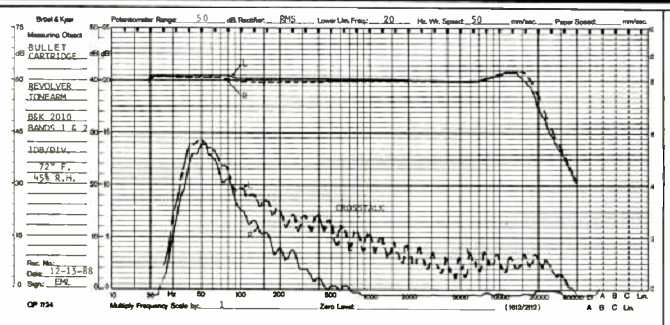
Fig. 1-Frequency response and crosstalk of Revolver Bullet cartridge and Standard
tonearm.
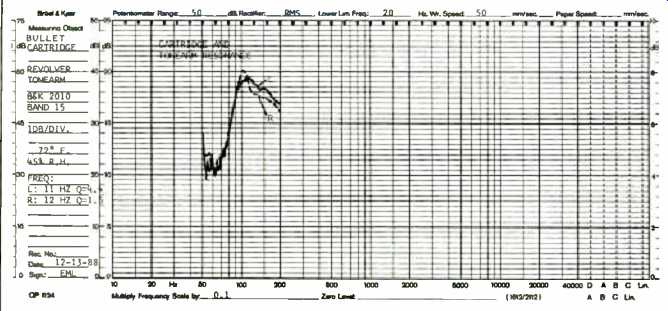
Fig. 2-Low-frequency tonearm cartridge resonance for right channel is at 11.0
Hz with a Q of 4.4 and for left channel is at 12.0 Hz with a Q of 1.5.
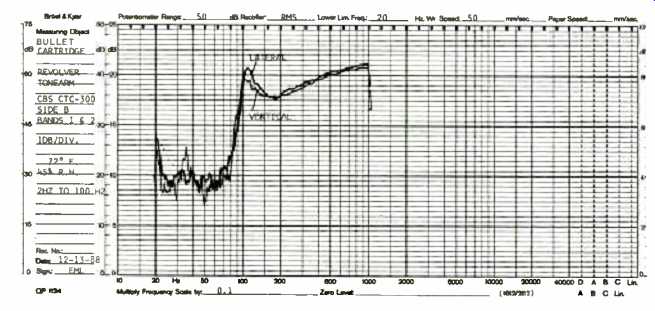
Fig. 3-Slow sweep from 2 to 100 Hz to check for lateral and vertical arm/
cartridge resonances. The Bullet's stylus compliance and the arm's mass are
well matched, but Q is higher than desirable; see text.
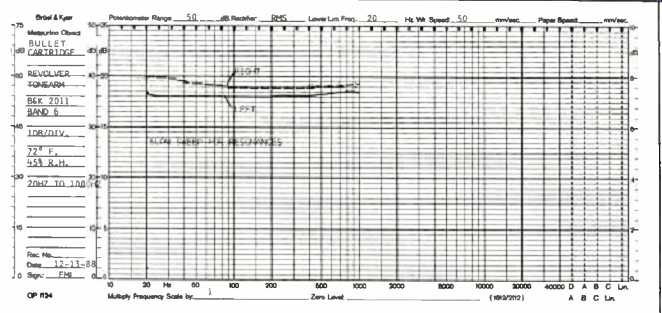
Fig. 4-Slow sweep from 20 Hz to 1 kHz to check for mechanical resonances in
arm.

Fig. 5--Output vs. time of arm/cartridge when mechanical impulse was applied
to armtube near headshell, with arm on rest.
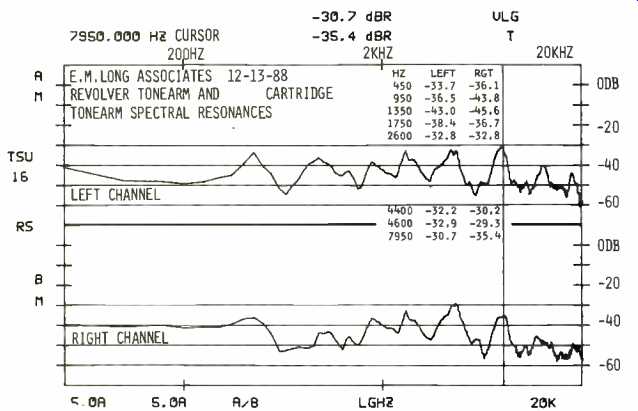
Fig.
6-Spectral output (averaged) of arm/cartridge for 16 mechanical impulses applied
to armtube. Several resonances, which could add coloration, are visible.
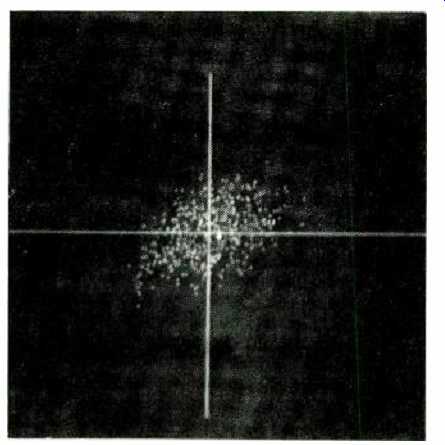
Fig. 7--Interchannel phase difference, using pink noise from B & K 2011,
band 7.

Fig. 8--Interchannel phase difference vs. frequency. At 20 kHz, the phase difference
is 130.7° (18.2 µS).
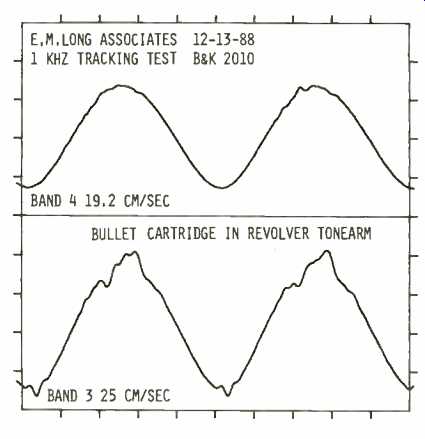
Fig. 9--Tracking of arm cartridge with 1-kHz test tones at 19.2 cm/S (top)
and 25 cm. S (highest level on B & K 2010). There is some jitter in the
25-cm/S waveform.
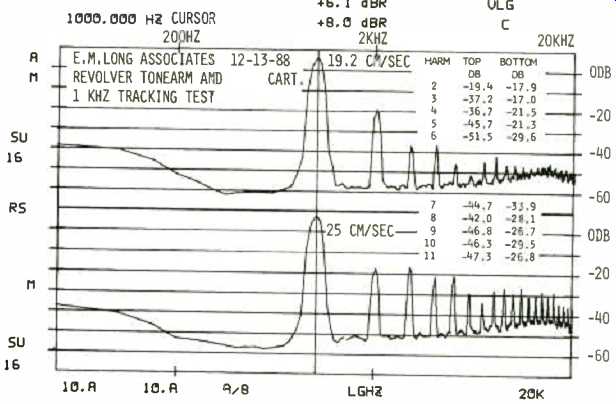
Fig. 10--Spectral analysis of the cartridge output when reproducing the signals
of Fig. 9. The increase in odd-order harmonics at the 25-cm/S level could increase
perceived brightness.
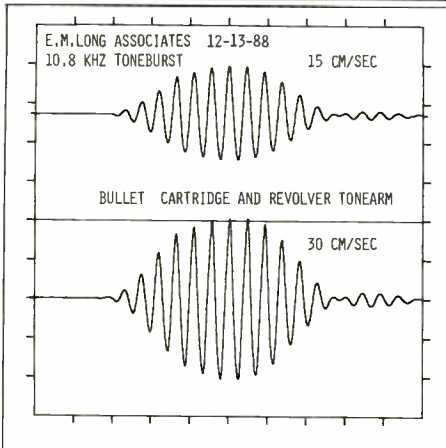
Fig. 11--Output from 15- and 30-cm/S, 10.8-kHz pulse test, using Shure TTR-103
test record. The asymmetry in the 30-cm/S signal could produce audible output
in the lower frequencies but is still reasonably good performance.
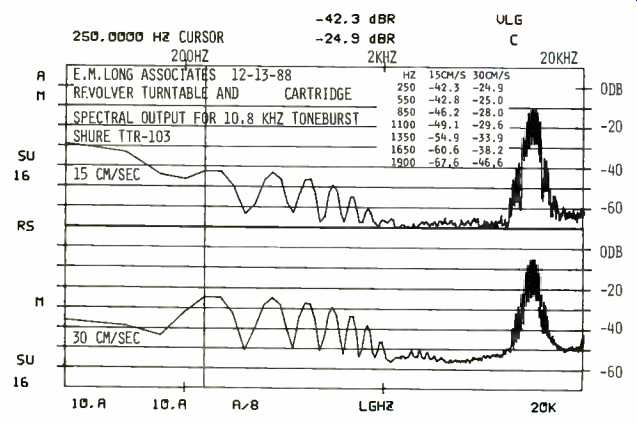
Fig. 12--Spectral analysis of distortion products from signals shown in Fig.
11 (average of 16 samples at each level). Note the rise in low-frequency content
at the 30-cm/S level, the result of the slight flattening shown in Fig. 11.
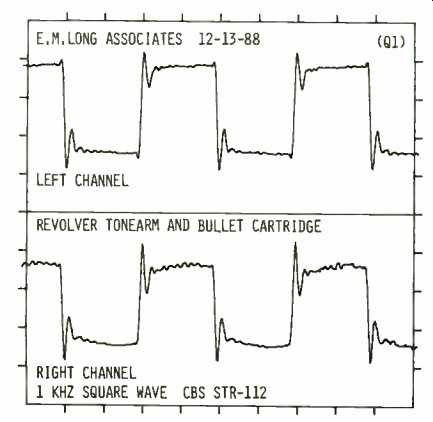
Fig. 13--Output from 1-kHz square wave, using CBS STR-112 test record.
The listening panel found little difficulty in hearing the differences in sound produced by the Revolver and the reference system. Considering the relatively low cost of the Revolver system, which consisted of the Revolver turntable and tonearm and the Bullet cartridge, this was not surprising. During these listening evaluations, the listening panel members had no idea of the cost of the Revolver system, because I wanted to eliminate any preconceptions that might be based on price.
Figure 1 shows the amplitude versus frequency response of the Revolver system with the Bullet cartridge. The smooth response indicates the care that has been taken to eliminate structural problems in the system which could cause vibrations or reflected energy. The peak in energy at 13 to 15 kHz is very well controlled, and the crosstalk is very low. The slight rise in the lower frequency range is apparently an artifact of the B & K 2010 test record, since it is evident for every cartridge I have tested.
The low-frequency resonance, due to the interaction of the cartridge compliance and the tonearm effective mass, is shown in Fig. 2. The frequency is slightly above 10 Hz but with a moderate 0, at least for the left channel. The listening panel's comments regarding the deep bass indicate that the quality of the reproduced sound was good but not as well defined as with the reference system. Figure 3, a slow sweep from 2 to 100 Hz with lateral and vertical groove modulation, shows that the compliance of the Bullet cartridge and the effective mass of the Revolver tonearm are well matched in both the lateral and vertical planes of motion, which is good. However, when the Q is this high, there is an effect on the sound in the lower bass range. The comments of listening panel members were that the Revolver system's bass sound was more "boomy" and "less de fined" than that of the reference system. There were also remarks about the rumble from certain records being more pronounced with the Revolver system.
Figure 4 shows the results of a slow sweep from 20 Hz to 1 kHz, to check for mechanical resonances in the Revolver system. The results are quite good, and there is little indication that there might be problems associated with reflected energy in the tonearm and cartridge system. Such problems can be caused by less than perfect junctions between parts of the system, such as between the cartridge and the headshell, the headshell and armtube, the armtube and pivot bearings, or the main pillar and turntable base.
Figure 5 shows the output versus time for a mechanical impulse applied to the armtube near the headshell. This is the position on the armtube where the sound of the tap test was described as a "tank." The damping is reasonably good, compared to other similar tonearms, despite apparent lack of damping material inside the armtube. Figure 6 shows the output spectrum from a series of 16 mechanical impulses applied to the tonearm tube. There are a number of prominent peaks in the range from 450 to 7,950 Hz; the peaks above this are at a lower level and probably have less effect on the sound. Some of the peaks are harmonically related to each other, being spaced about 400 to 500 Hz (or a multiple thereof) apart. This might account for the comments made by some panel members that the sound of brass seemed to be "enhanced" but "with changes in timbre." In fact, I think many of the other remarks regarding the sound of various instruments could be correlated to the colorations introduced by the tonearm. For instance, the sound of the piano was heard as "wooden" and "uneven"; the sound of strings as "harsh," and the sound of full orchestra as "muddy." I realize that these comments might seem to put the Revolver tonearm and Bullet cartridge in a bad light, but it must be remembered that the remarks were made when the panel members were comparing the tested combination to a very expensive, state-of-the-art turntable, tonearm, and cartridge combination.
Figure 7 shows the interchannel phase difference of the Bullet cartridge mounted in the Revolver tonearm; the source was the pink-noise test signal of the B & K 2011 test record, band 7. If there were no phase differences between the channels, the display would be a straight line, at 45°, from the lower-left to the upper-right quadrant. This display does not show the frequency range where the difference in phase occurs, but Fig. 8, a graph of interchannel phase difference versus frequency, does show this information.
The difference increases as the frequency increases. Since image localization is less affected by extreme high frequencies, the effect on the ability of panel members to localize sounds should not be very great. One panel member commented that cymbal sounds seemed to be "splattered" and that the reference system seemed "closer to the microphone" during the playing of the Sheffield Drum Record.
These remarks could be related to the information in Fig. 8, but they might also be correlated, to some extent, with the lower waveform in Fig. 9.
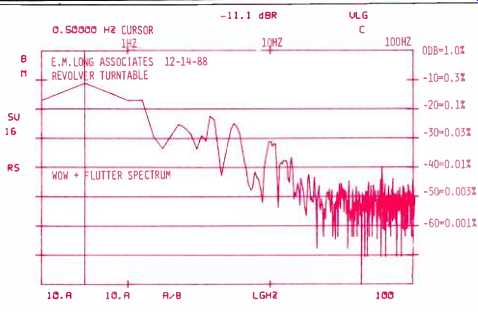
Fig. 14--Wow-and-flutter spectrum, from 0.25 to 100 Hz. The output peak at
the cursor (0.5 Hz) is related to the 33 1/3-rpm rotational frequency; the
small peak from 10 to 12 Hz shows the arm cartridge resonance.

Fig. 15--Speed drift over 40 S is indicated by the slowly changing heights
of the peaks.
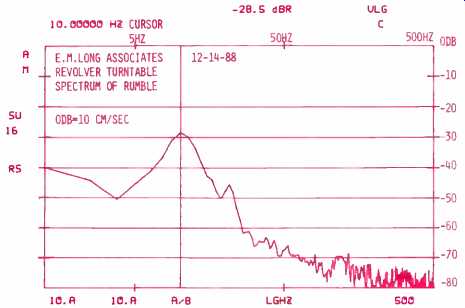
Fig. 16--Rumble spectrum. The rumble is extremely low, except where emphasized
by the arm/cartridge resonance (at cursor position); see text.
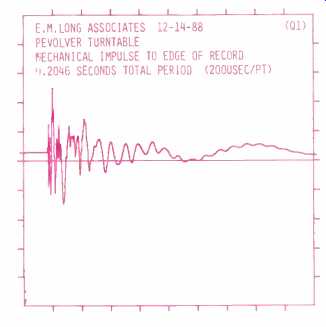
Fig.
17--Output vs. time for a mechanical impulse applied to the edge of a stationary
record with in a groove. The turntable mat is clearly not removing much energy
from the record.
Figure 9 shows the output versus time for two different levels of the 1-kHz signal on the B & K 2010 test record. The upper trace shows the output for a level of 19.2 cm/S. A slight amount of distortion can be seen on the top of the waveform. This is a very high level and one at which many cartridges have difficulty tracking without distortion. The lower trace shows much higher distortion and was made using the 25-cm/S band, which is the highest level cut on the B & K 2010 record. Some cartridge/arm combinations cannot track this level. The spectrum of the output for these two test levels is shown in Fig. 10. The increase in odd-order harmonics, which tends to cause the sound for some types of program material to be noted "bright" and even "harsh" by panel members, can be clearly seen in the lower trace of Fig. 10. I should mention that there was some instability or jitter in the lower trace of Fig. 9 during the test. This could be the reason for the comment about the cymbal "splatter." Figure 11 shows the output versus time for the 10.8-kHz tone burst of the Shure TTR-103 test record. A small amount of asymmetry or flattening of the top of the lower trace can be seen; this trace is from the highest level (30 cm/S) on the Shure record. This is reasonably good performance by the Revolver tonearm and cartridge combination. The spectrum due to the 10.8-kHz tracking test is shown in Fig. 12. The output at lower frequencies is the result of the fact that the Revolver combination cannot completely cope with the higher 30-cm/S level. Compare the dB levels for the frequencies shown in Fig. 12, and you will see that the 10.8-kHz tone burst at 30 cm/S produces quite a bit more output at lower frequencies. This can be correlated with comments about the brass, which sounded "muted" and "lackluster" to at least one panel member, compared to the reference system.
The overshoot and notch at the beginning of the 1-kHz square wave in Fig. 13 are the result of the phase shift with frequency which increases at higher frequencies. This is related to the fall in output above 15 kHz shown in Fig. 1; this is still a respectable result. While the Bullet cartridge may not have the transparent quality associated with the finest cartridges, it is still capable of producing very good sound.
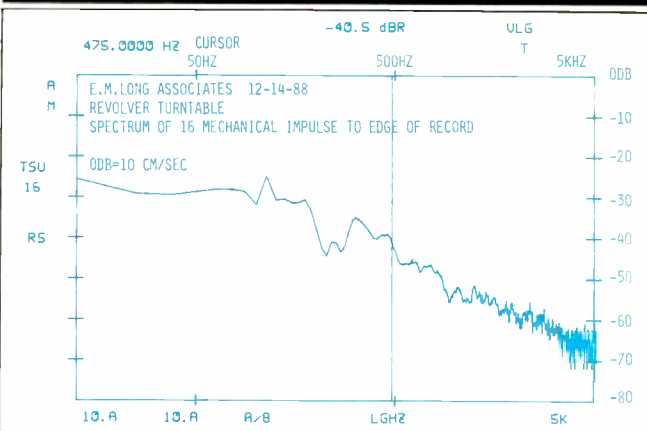
Fig. 18--Spectral output (averaged) from 16 mechanical impulses applied as
in Fig. 17. Note the considerable output below 475 Hz; see text.
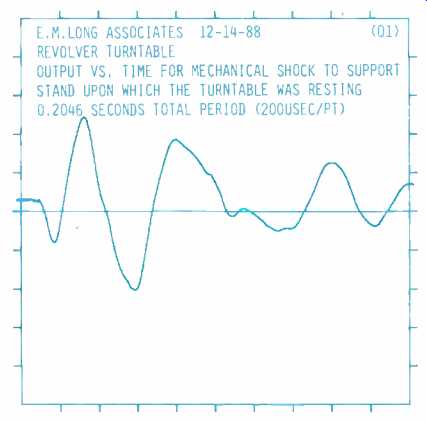
Fig. 19--Output vs. time for a mechanical impulse applied to the platform
on which the turntable was resting. Isolation from mechanical shock is poor.
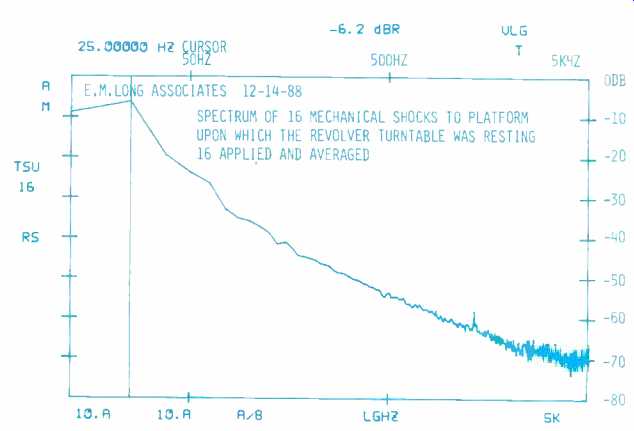
Fig. 20--Spectral output (averaged) from 16 mechanical impulses applied as
in Fig. 19. The energy is concentrated at the lower frequencies and is well
controlled; see text.
Figure 14 shows the wow and flutter spectrum of the Revolver turntable. Most of the output is at 0.5 Hz, which is the closest spectral line to the 0.56-Hz turntable rotational frequency at 33 1/3 rpm (33 1/3 divided by 60 equals 0.56).
The output at the tonearm and cartridge resonance can also be seen at about 10 to 12 Hz. The comments about the sound of the piano being "more blurred" can be related directly to the wow and flutter performance of the Revolver turntable. The variation in speed can be seen as the cyclical variations shown in Fig. 15. The drift, over this period of about 40 S, can be seen in the slowly changing heights of the peaks.
Figure 16 shows that the rumble is extremely low, except at the tonearm and cartridge resonance. It is mainly this resonance that accounts for the perceived increase in rumble, noted by all the panel members, when playing records with lots of rumble, rather than the turntable itself. This is the main reason why I prefer to show the spectrum of the rumble rather than give numbers alone. The numbers, by themselves, can be very misleading.
Figure 17 shows the output versus time for a mechanical impulse applied to the edge of a stationary record and with the phono stylus resting in the groove near the center of the record. This test is made to determine the effectiveness of the turntable mat in removing delayed mechanical energy from the record. The main purpose of the Revolver Starmat is to remove static electricity from a record and not necessarily to remove mechanical energy. This is clearly evident from the fact that there is quite a large output from the cartridge. This delayed energy can cause the sound to be perceived as being "blurred" for some types of program material.
The spectrum produced by a series of 16 mechanical impulses applied to the edge of a record and averaged is shown in Fig. 18. The spectral output below 475 Hz is considerable and can contribute to the impression that complex sounds, such as that of full orchestra, are less detailed than they might be if this delayed energy were absorbed by the record mat.
Figure 19 shows the output versus time for a mechanical impulse applied to the platform on which the Revolver turn table was resting. The two strips of neoprene rubber be tween the upper and lower turntable platforms are aligned in such a way as to be in parallel with the stylus when it is somewhere near the middle of a 12-inch record. The idea is to cause the energy to be in the same plane as the length of the stylus cantilever, a direction in which it is not free to move. Although the cartridge is in this optimum position, it is apparent that the mechanical energy does cause consider able output from the cartridge. The spectrum of energy from a series of 16 mechanical shocks, applied to the platform and averaged, is shown in Fig. 20. The energy is concentrated at the lower frequencies and is well controlled. I recommend that the Revolver turntable system be placed on a wall-mounted shelf if you discover that mechanical shocks, induced by dancing or even by ordinary footsteps, are a problem.
Conclusions
For those in the market for a turntable, tonearm, and cartridge with a total cost of several hundred dollars, it will probably be worth their while to read my reviews of the Dual CS 5000 (November 1988) and the Ariston Forte turntable and Enigma tonearm (December 1988). Aside from questions of final delivered price, it is also interesting to consider if the Ortofon X3-MC cartridge would be worth the additional $75 it would cost to add it to the Revolver system.
In any case, if the fellow I discussed at the outset of this report had asked me whether the Revolver system, including the Bullet cartridge, was a good choice for use in a moderately priced record-playing system, I would definitely have said, "yes."
(Source: Audio magazine, Apr. 1989)
Also see:
Revox Model B 790 Turntable (Jun. 1979)
Ariston Forte Turntable and Enigma Tonearm (Dec. 1988)
Dual CS 5000 Turntable and Ortofon X3-MC Cartridge (Nov. 1988)
Thorens TD 320 Turntable and TP 16 MK III Tonearm (Mar. 1987)
= = = =